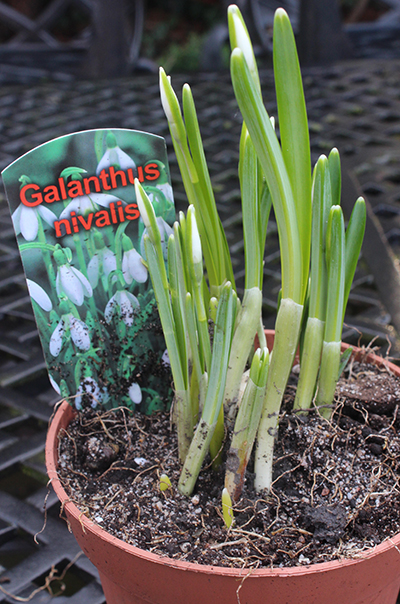You don’t have to be a galanthophile to admire the simple beauty of a compact bunch of nodding snowdrops. Although these delicate drooping gems don’t quite herald the start of spring, they definitely raise a smile on dreary winter days and exude the promise of better things to come in another glorious year of gardening. Enough sofa slothing, they say. It’s time to get back out here.
I confess to being a little disappointed though, as most of the snowdrops I planted ‘in the green’ last year haven’t emerged this year. So, I’ve being doing some research to find out where I went wrong.
Planting ‘in the green’
I definitely did the right thing by planting ‘in the green’. Basically, this means planting them while they still have leaves (the same goes for aconites and native bluebells). The best time to do this is as the foliage starts to die back (in late April/May), so that most of the goodness has already been returned to the bulb.
You can buy them freshly dug up …
or potted …
If the former, plant them as soon as you can; once lifted, the bulbs are prone to drying out. Plant them at the level they were previously growing, i.e. to the level of the white area on the neck of the bulb, which was previously under the soil. And don’t forget to give the plants a good water.
Planting from bulbs
You can also plant dry bulbs in the autumn, but they are generally less successful. If you go for this option, buy them as soon as you seen them on display and soak them overnight in a bowl of cold water before planting the following day. When it comes to snowdrops, a dry bulb is a dead bulb.
Other methods of propagation
Snowdrops can also be propagated by ‘twin scaling’ or ‘chipping’. Both of these methods are described on the RHS website.
Keep them moist
Now this is probably where I went wrong, as we had quite a dry summer last year. I planted my snowdrop bundles in a shady corner spot on clay-based soil. They do best in partial shade (they’re woodland plants after all), so that was fine, but they do prefer a well-drained soil with lots of organic material.
There’s a good chance that in my heavy clay soil, they dried out at some point last year, and when they dry out … they die. Unlike daffodils and tulips, snowdrop bulbs do not have a water-retaining skin, so they dehydrate very quickly.
Where to see snowdrops

Snowdrop carpet at Bank Hall, Bretherton, Lancashire, UK (Bankhallbretherton at en.wikipedia CC BY 3.0 – http://creativecommons.org/licenses/by/3.0, via Wikimedia Commons)
If, like me, you have a limited number of snowdrops to enjoy in your own garden this year, then why not take a snowdrop walk this weekend? Check out this Country Life article for the best places to see snowdrops right now. Stroll through a woodland carpeted in drifts of snowdrops and see exactly why they so inspired William Wordsworth.
LONE Flower, hemmed in with snows and white as they
But hardier far, once more I see thee bend
Thy forehead, as if fearful to offend,
Like an unbidden guest. Though day by day,
Storms, sallying from the mountain-tops, waylay
The rising sun, and on the plains descend;
Yet art thou welcome, welcome as a friend
Whose zeal outruns his promise! Blue-eyed May
Shall soon behold this border thickly set
With bright jonquils, their odours lavishing 10
On the soft west-wind and his frolic peers;
Nor will I then thy modest grace forget,
Chaste Snowdrop, venturous harbinger of Spring,
And pensive monitor of fleeting years!
– To a Snowdrop, William Wordsworth, 1819.
But hurry! Although the snowdrops will be around for a few more weeks, my tête-à-têtes are already making a showy bid for supremacy. Enjoy the snowdrops while you can, then say goodbye to winter, because spring is most definitely on its way.





